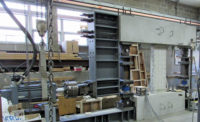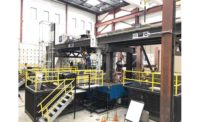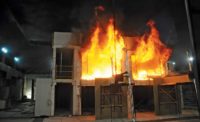 |
| INTEGRATION Structure, building systems support transparent design. (Photo courtesy of Murphy /Jahn Architects) |
Open architecture does not have to be sacrificed in this age of security jitters. So said experts during a recent conference in Chicago called Transparency: the Art and Science in Building Design, sponsored by the Council on Tall Buildings and Urban Habitat, Chicago.
Terry Palmer, a principal of structural engineer Magnusson Klemencic Associates, Seattle, cautioned attendees of the April 15-16 conference not to blow the subject of blast resistance out of proportion. He presented a concept for cable-supported glass walls outfitted with friction, viscous or yielding dampers to absorb blast pressure. Our nonlinear blast analysis shows that the effective pressure on the curtain wall will be reduced tenfold, said Palmer. That makes the damper system much more effective than a nondampened or stiff, robust system, he said.
MKA has performed several pull tests on the dampers to prove that the slip load is predictable based upon the clamping force applied within the damper.
 |
| NO SHARDS Even rigid walls can remain standing, with shattered glass contained. (Photo courtesy of Seele) |
Blast tests on rigid, frame-supported glass walls and on cable-supported walls with dampers were performed last year at an independent test laboratory, under the sponsorship of curtain wall supplier Seele GmbH & Co., Gersthofen, Germany. The damper system had a phenomenal influence on the cable walls performance under blast, said Hans Frey, vice president of Seele LP, Chicago, also a presenter at the conference.
Until the test, architects, blast consultants and glass suppliers had predicted a glass wall would fall under blast conditions, said Palmer, who had first approached Seele about damping.
The idea is to make a wall soft, so it absorbs energy. The goal is to keep the panes from pulling out and to make sure glass shards are not
|




Post a comment to this article
Report Abusive Comment